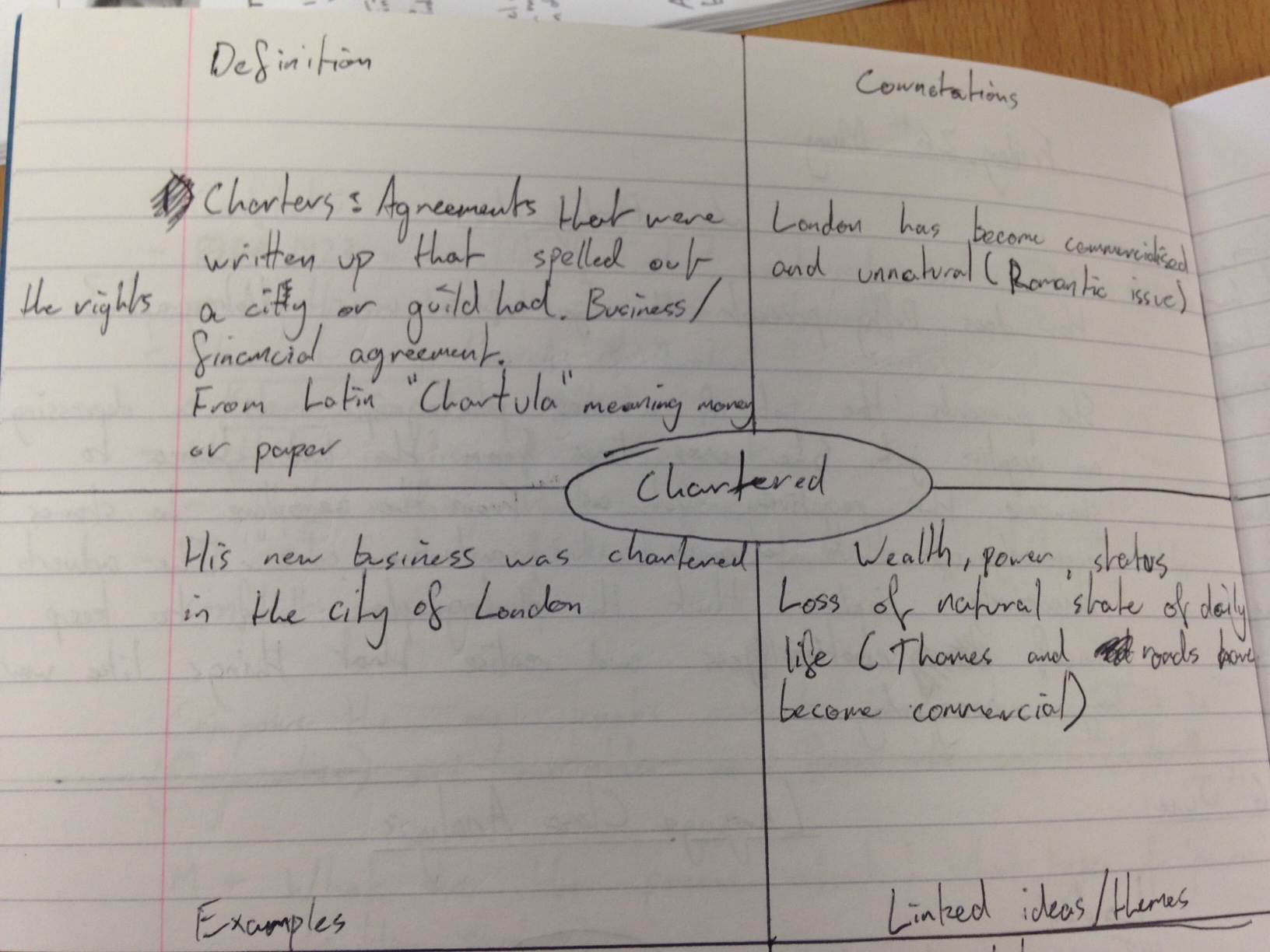The ‘Frayer model‘ is a long-standing graphic organiser that has been deployed in classrooms with success for decades (it was first conceived Dorothy Frayer and her colleagues at the University of Wisconsin). It is a simple but effective model to help students to organise their understanding of a new academic term or complex vocabulary choice.
The traditional model is as follows:

I have been using the ‘Frayer model’ for around two years now in my English lessons. It has proven a useful model to help me explicitly focus my teaching of important literary terms in English. Last year, I undertook a ‘disciplined inquiry’ on my practice to explore if it proved an effective way to teach complex vocabulary in the GCSE poetry I was teaching.
I decided to adapt the typical ‘Frayer Model’ to make it more appropriate to literature study (the flexibility and simplicity of this graphic organiser is why it proves so useable). Here, a student selects the word “chartered” from William Blake’s poem, ‘London’, using our adapted headings:

Here is an extract from the resultant close analysis of the poem, revealing the student’s use of their ‘Frayer model’ (with some peer feedback):

Does the ‘Frayer model’ alone transform understanding of words? Well, no – not really. Still, I found it a quick and handy strategy to explicitly closely analyse important vocabulary choices in English. In subsequent questionnaire feedback, numerous students commented that the model was helpful in getting them to recognise the most important ‘keystone’ words and ideas to analyse.
The ‘Frayer Model’ in Science
Over the last year at Huntington school we have had a focus on help our students access the more challenging reading and academic vocabulary demands of the new curriculum. We have focused on some generic strategies, like the ‘Frayer model’ and similar graphic organisers, but crucially, these have been applied in our secondary school subject disciplines.
Alister Talbot, one of our Science teachers, has been inquiring about using the ‘Frayer model’ as tool in his Key Stage 3 Science lessons:
“I’ve been using the ‘Frayer model’ in my year 8 science lessons to explore key lesson vocabulary in more detail. I’ve used it to baseline my students – asking them what they already know about the word and where they have used it previously (science setting or non-science setting). We’ve then moved onto exploring in the word in a bit more detail – looking at the etymology of the word and also the morphology.
For example, the key word ‘sub-atomic’ we explored what ‘sub’ meant and other words which contain ‘sub’. After exploring the word more, I have used the ‘Frayer model’ to get the students to write some definitive notes on the word – either the key definition or a diagram relating to the specification. Finally, I’ve encouraged students to use the word – either in using the key word in response to an exam question/writing their own explanation of a concept using the key word.
My year 8 students seem to have very much enjoyed using the Frayer model – they have especially enjoyed discussing where they have come across the word previously and the variety of out-of-classroom-contexts which they have come up with have been great. They students also enjoy learning about the morphology and etymology of the word – although this does take time during the lessons and in the great scheme of preparing for exam I (indeed, some of my students have questioned this). Of particular interest has been observing how pupils have used the word after being taught the content of the lesson and how they have answered exam questions – many have written explanations with a real grasp of the true meaning of the word, not just a superficial overview.”
You can see an example from Alister’s teaching here:

You can see that Alister (and his students!) ask valid questions about the ‘why’ and ‘when’ of using the ‘Frayer model’, not just ‘what is it?’ On a subject level, these type of questions are exactly what we should be asking. Some researchers have critiqued the time-intensive nature of the approach. We should of course explain our methods to our students too when possible. As academic literacy proves such a challenge for our students in Science, perhaps without them realising it, it is important to question how we best communicate the essential language of our subject domains.
In keeping with the flexibility of the ‘Frayer model’ across the curriculum, research has been undertaken on the effectiveness of the Frayer model for mathematics teaching, as well as a general strategy for acquiring and deepening vocabulary knowledge. It can be used by teachers to explicitly teach key vocabulary, prove a prompt for discussion, or used by students to record their word knowledge with greater depth than is typical.
The ‘Frayer model’ is now firmly lodged into my teacher toolkit. And that isn’t just because ‘Frayer’ is a homophone reminder of my lovely daughter ‘Freya’!

I love the frayer model! I used it in my demo lesson to get into my Masters in teaching program. I also like that you can simplify it with pictures for younger students.
Pingback: Frayer Models | Mathematics, Learning and Technology
Did the teacher use whole-group instruction during this lesson? Or did he have the kids use non-fiction text to fill it out and then they discussed? Thanks
Pingback: Lesson Evaluation 1 – The Frayer Model | DJG Teaching
Pingback: 'We Did Vocabulary Last Year'
Pingback: Is it time to KO the Knowledge Organiser?
Pingback: Academic Vocabulary and Schema Building
Pingback: Academic Vocabulary and Schema Building - Education Survey
Pingback: Is it time to KO the Knowledge Organiser? - Education Survey
Pingback: Three Pillars of Vocabulary Teaching
Pingback: How I Teach Programming #1 – Predict & Run | @MrAColley